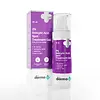What's inside
What's inside
 Key Ingredients
Key Ingredients

 Benefits
Benefits

 Concerns
Concerns

No concerns
 Ingredients Side-by-side
Ingredients Side-by-side

Water
Skin ConditioningPropanediol
SolventEthoxydiglycol
HumectantKojic Acid
AntioxidantNiacinamide
SmoothingPentylene Glycol
Skin ConditioningAlpha-Arbutin
AntioxidantDimethyl Isosorbide
SolventGlycerin
HumectantEpigallocatechin Gallatyl Glucoside
AntioxidantSodium PCA
HumectantPanthenol
Skin ConditioningSodium Hyaluronate
HumectantAstragalus Gummifer Gum
Emulsion StabilisingHydroxypropyl Methylcellulose
Emulsion StabilisingPhenoxyethanol
PreservativeCaprylyl Glycol
EmollientEthylhexylglycerin
Skin ConditioningTrisodium Ethylenediamine Disuccinate
Proline
Skin ConditioningHydroxyproline
Skin ConditioningCI 19140
Cosmetic ColorantWater, Propanediol, Ethoxydiglycol, Kojic Acid, Niacinamide, Pentylene Glycol, Alpha-Arbutin, Dimethyl Isosorbide, Glycerin, Epigallocatechin Gallatyl Glucoside, Sodium PCA, Panthenol, Sodium Hyaluronate, Astragalus Gummifer Gum, Hydroxypropyl Methylcellulose, Phenoxyethanol, Caprylyl Glycol, Ethylhexylglycerin, Trisodium Ethylenediamine Disuccinate, Proline, Hydroxyproline, CI 19140
Water
Skin ConditioningCetearyl Alcohol
EmollientCetearyl Glucoside
EmulsifyingSulfur
AntiseborrhoeicCaprylic/Capric Triglyceride
MaskingGlycerin
HumectantLanolin
EmollientGlyceryl Stearate
EmollientSalicylic Acid
MaskingStearic Acid
CleansingCetyl Palmitate
EmollientDicetyl Phosphate
EmulsifyingCeteth-10 Phosphate
CleansingSodium Hyaluronate
HumectantSqualane
EmollientHydroxyethyl Acrylate/Sodium Acryloyldimethyl Taurate Copolymer
Emulsion StabilisingSteareth-21
CleansingSorbitan Stearate
EmulsifyingSteareth-2
EmulsifyingPhenoxyethanol
PreservativeEthylhexylglycerin
Skin ConditioningSodium Hydroxide
BufferingDisodium EDTA
Water, Cetearyl Alcohol, Cetearyl Glucoside, Sulfur, Caprylic/Capric Triglyceride, Glycerin, Lanolin, Glyceryl Stearate, Salicylic Acid, Stearic Acid, Cetyl Palmitate, Dicetyl Phosphate, Ceteth-10 Phosphate, Sodium Hyaluronate, Squalane, Hydroxyethyl Acrylate/Sodium Acryloyldimethyl Taurate Copolymer, Steareth-21, Sorbitan Stearate, Steareth-2, Phenoxyethanol, Ethylhexylglycerin, Sodium Hydroxide, Disodium EDTA
Ingredients Explained
These ingredients are found in both products.
Ingredients higher up in an ingredient list are typically present in a larger amount.
Ethylhexylglycerin (we can't pronounce this either) is commonly used as a preservative and skin softener. It is derived from glyceryl.
You might see Ethylhexylglycerin often paired with other preservatives such as phenoxyethanol. Ethylhexylglycerin has been found to increase the effectiveness of these other preservatives.
Glycerin is already naturally found in your skin. It helps moisturize and protect your skin.
A study from 2016 found glycerin to be more effective as a humectant than AHAs and hyaluronic acid.
As a humectant, it helps the skin stay hydrated by pulling moisture to your skin. The low molecular weight of glycerin allows it to pull moisture into the deeper layers of your skin.
Hydrated skin improves your skin barrier; Your skin barrier helps protect against irritants and bacteria.
Glycerin has also been found to have antimicrobial and antiviral properties. Due to these properties, glycerin is often used in wound and burn treatments.
In cosmetics, glycerin is usually derived from plants such as soybean or palm. However, it can also be sourced from animals, such as tallow or animal fat.
This ingredient is organic, colorless, odorless, and non-toxic.
Glycerin is the name for this ingredient in American English. British English uses Glycerol/Glycerine.
Learn more about GlycerinPhenoxyethanol is a preservative that has germicide, antimicrobial, and aromatic properties. Studies show that phenoxyethanol can prevent microbial growth. By itself, it has a scent that is similar to that of a rose.
It's often used in formulations along with Caprylyl Glycol to preserve the shelf life of products.
Sodium Hyaluronate is hyaluronic acid's salt form. It is commonly derived from the sodium salt of hyaluronic acid.
Like hyaluronic acid, it is great at holding water and acts as a humectant. This makes it a great skin hydrating ingredient.
Sodium Hyaluronate is naturally occurring in our bodies and is mostly found in eye fluid and joints.
These are some other common types of Hyaluronic Acid:
Learn more about Sodium HyaluronateWater. It's the most common cosmetic ingredient of all. You'll usually see it at the top of ingredient lists, meaning that it makes up the largest part of the product.
So why is it so popular? Water most often acts as a solvent - this means that it helps dissolve other ingredients into the formulation.
You'll also recognize water as that liquid we all need to stay alive. If you see this, drink a glass of water. Stay hydrated!
Learn more about Water